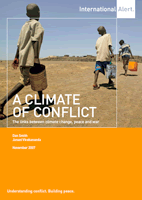| Inhalt
/ Table of Contents |
Seite
/ Page
|
| EXECUTIVE
SUMMARY |
3
|
| 1.
INTRODUCTION: CLIMATE CHANGE, DEVELOPMENT AND PEACEBUILDING |
7
|
| 2.
THE DOUBLE-HEADED PROBLEM OF CLIMATE CHANGE AND VIOLENT CONFLICT |
9
|
| Risk
and risk management |
9
|
| The
consequences of consequences |
10
|
| Diagram:
The Impact of Climate Change: Two possible roads ahead |
10
|
| Box
1: Algeria |
11
|
| Box
2: Darfur |
12
|
| Box
3: Peru |
14
|
| Box
4: Bangladesh |
16
|
| Box
5: Karachi |
17
|
| Climate
change and global insecurity |
17
|
| Map:
The Double-Headed Risk |
18
|
| Governance
matters |
20
|
| Box
6: Mali and Chad |
20
|
| Key
risks |
21
|
| 3.
THE UNIFIED SOLUTION |
23
|
| Why
the international community should act |
23
|
| Regional
cooperation |
24
|
| A
role for the private sector |
25
|
| Complexities
of cooperation |
25
|
| Box
7: Current frameworks on climate change |
26
|
| Peacebuilding |
30
|
| Linking
peacebuilding and climate adaptation |
31
|
| Box
8: Liberia |
31
|
| Developing
social resilience |
33
|
| Box
9: Nepal |
34
|
| The
practicalities of adaptation |
36
|
| 4.
CONCLUSIONS AND RECOMMENDATIONS |
37
|
| Twelve
recommendations for addressing climate change in fragile states |
38
|
| REFERENCES |
42
|
| LIST
OF STATES AT RISK |
44
|

